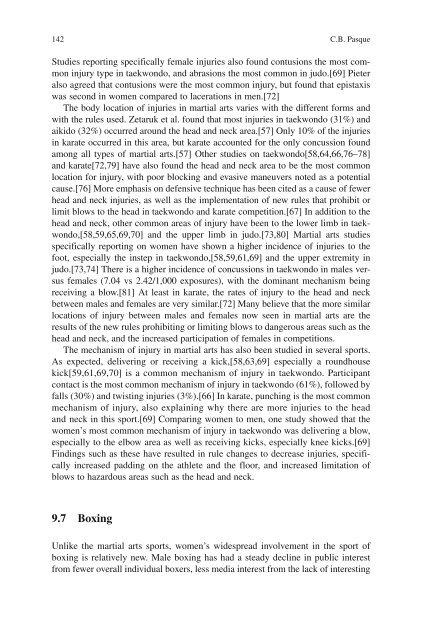Nutrition in Combat Sports
Nutrition in Combat Sports
Nutrition in Combat Sports
Create successful ePaper yourself
Turn your PDF publications into a flip-book with our unique Google optimized e-Paper software.
142 C.B. Pasque<br />
Studies report<strong>in</strong>g specifically female <strong>in</strong>juries also found contusions the most common<br />
<strong>in</strong>jury type <strong>in</strong> taekwondo, and abrasions the most common <strong>in</strong> judo. [69] Pieter<br />
also agreed that contusions were the most common <strong>in</strong>jury, but found that epistaxis<br />
was second <strong>in</strong> women compared to lacerations <strong>in</strong> men. [72]<br />
The body location of <strong>in</strong>juries <strong>in</strong> martial arts varies with the different forms and<br />
with the rules used. Zetaruk et al. found that most <strong>in</strong>juries <strong>in</strong> taekwondo (31%) and<br />
aikido (32%) occurred around the head and neck area. [57] Only 10% of the <strong>in</strong>juries<br />
<strong>in</strong> karate occurred <strong>in</strong> this area, but karate accounted for the only concussion found<br />
among all types of martial arts.[ 57] Other studies on taekwondo [58, 64, 66, 76– 78]<br />
and karate [72, 79] have also found the head and neck area to be the most common<br />
location for <strong>in</strong>jury, with poor block<strong>in</strong>g and evasive maneuvers noted as a potential<br />
cause.[ 76] More emphasis on defensive technique has been cited as a cause of fewer<br />
head and neck <strong>in</strong>juries, as well as the implementation of new rules that prohibit or<br />
limit blows to the head <strong>in</strong> taekwondo and karate competition. [67 ] In addition to the<br />
head and neck, other common areas of <strong>in</strong>jury have been to the lower limb <strong>in</strong> taekwondo,<br />
[58, 59, 65, 69, 70] and the upper limb <strong>in</strong> judo. [73, 80] Martial arts studies<br />
specifically report<strong>in</strong>g on women have shown a higher <strong>in</strong>cidence of <strong>in</strong>juries to the<br />
foot, especially the <strong>in</strong>step <strong>in</strong> taekwondo, [58, 59, 61, 69] and the upper extremity <strong>in</strong><br />
judo. [73, 74] There is a higher <strong>in</strong>cidence of concussions <strong>in</strong> taekwondo <strong>in</strong> males versus<br />
females (7.04 vs 2.42/1,000 exposures), with the dom<strong>in</strong>ant mechanism be<strong>in</strong>g<br />
receiv<strong>in</strong>g a blow. [81] At least <strong>in</strong> karate, the rates of <strong>in</strong>jury to the head and neck<br />
between males and females are very similar. [72] Many believe that the more similar<br />
locations of <strong>in</strong>jury between males and females now seen <strong>in</strong> martial arts are the<br />
results of the new rules prohibit<strong>in</strong>g or limit<strong>in</strong>g blows to dangerous areas such as the<br />
head and neck, and the <strong>in</strong>creased participation of females <strong>in</strong> competitions.<br />
The mechanism of <strong>in</strong>jury <strong>in</strong> martial arts has also been studied <strong>in</strong> several sports.<br />
As expected, deliver<strong>in</strong>g or receiv<strong>in</strong>g a kick, [58, 63, 69] especially a roundhouse<br />
kick [59, 61, 69, 70 ] is a common mechanism of <strong>in</strong>jury <strong>in</strong> taekwondo. Participant<br />
contact is the most common mechanism of <strong>in</strong>jury <strong>in</strong> taekwondo (61%), followed by<br />
falls (30%) and twist<strong>in</strong>g <strong>in</strong>juries (3%).[ 66] In karate, punch<strong>in</strong>g is the most common<br />
mechanism of <strong>in</strong>jury, also expla<strong>in</strong><strong>in</strong>g why there are more <strong>in</strong>juries to the head<br />
and neck <strong>in</strong> this sport.[ 69] Compar<strong>in</strong>g women to men, one study showed that the<br />
women’s most common mechanism of <strong>in</strong>jury <strong>in</strong> taekwondo was deliver<strong>in</strong>g a blow,<br />
especially to the elbow area as well as receiv<strong>in</strong>g kicks, especially knee kicks.[ 69]<br />
F<strong>in</strong>d<strong>in</strong>gs such as these have resulted <strong>in</strong> rule changes to decrease <strong>in</strong>juries, specifically<br />
<strong>in</strong>creased padd<strong>in</strong>g on the athlete and the floor, and <strong>in</strong>creased limitation of<br />
blows to hazardous areas such as the head and neck.<br />
9.7 Box<strong>in</strong>g<br />
Unlike the martial arts sports, women’s widespread <strong>in</strong>volvement <strong>in</strong> the sport of<br />
box<strong>in</strong>g is relatively new. Male box<strong>in</strong>g has had a steady decl<strong>in</strong>e <strong>in</strong> public <strong>in</strong>terest<br />
from fewer overall <strong>in</strong>dividual boxers, less media <strong>in</strong>terest from the lack of <strong>in</strong>terest<strong>in</strong>g

















